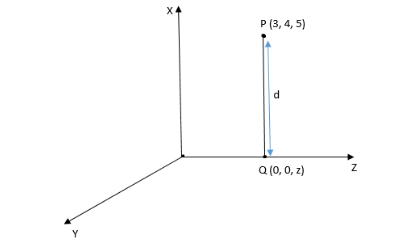
Write the distance of the point P (3, 4, 5) from z-axis______
Answer
553.8k+ views
Hint: We know that distance between points \[P({x_1},{y_1},{z_1})\] and \[Q({x_2},{y_2},{z_2})\] is given by \[PQ = \sqrt {{{({x_1} - {x_2})}^2} + {{({y_1} - {y_2})}^2} + {{({z_1} - {z_2})}^2}} \] . We also know that any point on the Z-axis has a coordinate \[(0,0,z)\] . That is X and Y coordinates are zero. We find the value of \[z\] and then we can find the distance between P and point on a Z-axis.
Complete step-by-step answer:
Let Q be any point on the Z-axis then its coordinates are \[Q(0,0,z)\] and \[P(3,4,5)\] .
Look at the below diagram, so that we can understand better.

We need to find the distance between PQ, before that we need the value of the coordinate of Q. That is \[z\] .
Now the direction ratio of PQ is proportional to \[ \Rightarrow (3 - 0,{\text{ 4 - 0, 5 - z) = (3,4,5 - z)}}\] .
We can see from the figure that PQ is perpendicular to the Z-axis then,
(We know that, if two lines are perpendicular then their product of sum of direction ratios are equal to zero.)
\[ \Rightarrow (3 \times 0) + (4 \times 0) + (1 \times {\text{5 - z}}) = 0\]
\[ \Rightarrow 0 + 0 + 5 - z = 0\]
\[ \Rightarrow 5 - z = 0\]
\[ \Rightarrow z = 5\]
Hence the coordinates of the point \[Q(0,0,5)\] .
Now to find the distance between PQ, \[P(3,4,5)\] and \[Q(0,0,5)\]
Using the distance formula, that is \[PQ = \sqrt {{{({x_1} - {x_2})}^2} + {{({y_1} - {y_2})}^2} + {{({z_1} - {z_2})}^2}} \]
\[ \Rightarrow PQ = \sqrt {{{(3 - 0)}^2} + {{(4 - 0)}^2} + {{(5 - 5)}^2}} \]
\[ \Rightarrow PQ = \sqrt {9 + 16 + 0} \]
\[ \Rightarrow PQ = \sqrt {25} \]
\[ \Rightarrow PQ = 5\]
Hence, the distance of the point P (3, 4, 5) from the z-axis is $5$ units.
So, the correct answer is “5 units”.
Note: If the problem is based on the Conic section or three dimensional geometry always express the given problem into the diagram so that we will have a better understanding of the problem. In the above problem we notice that the line PQ is perpendicular to the Z-axis by looking into the diagram. After that all we did is a simple calculation.
Complete step-by-step answer:
Let Q be any point on the Z-axis then its coordinates are \[Q(0,0,z)\] and \[P(3,4,5)\] .
Look at the below diagram, so that we can understand better.

We need to find the distance between PQ, before that we need the value of the coordinate of Q. That is \[z\] .
Now the direction ratio of PQ is proportional to \[ \Rightarrow (3 - 0,{\text{ 4 - 0, 5 - z) = (3,4,5 - z)}}\] .
We can see from the figure that PQ is perpendicular to the Z-axis then,
(We know that, if two lines are perpendicular then their product of sum of direction ratios are equal to zero.)
\[ \Rightarrow (3 \times 0) + (4 \times 0) + (1 \times {\text{5 - z}}) = 0\]
\[ \Rightarrow 0 + 0 + 5 - z = 0\]
\[ \Rightarrow 5 - z = 0\]
\[ \Rightarrow z = 5\]
Hence the coordinates of the point \[Q(0,0,5)\] .
Now to find the distance between PQ, \[P(3,4,5)\] and \[Q(0,0,5)\]
Using the distance formula, that is \[PQ = \sqrt {{{({x_1} - {x_2})}^2} + {{({y_1} - {y_2})}^2} + {{({z_1} - {z_2})}^2}} \]
\[ \Rightarrow PQ = \sqrt {{{(3 - 0)}^2} + {{(4 - 0)}^2} + {{(5 - 5)}^2}} \]
\[ \Rightarrow PQ = \sqrt {9 + 16 + 0} \]
\[ \Rightarrow PQ = \sqrt {25} \]
\[ \Rightarrow PQ = 5\]
Hence, the distance of the point P (3, 4, 5) from the z-axis is $5$ units.
So, the correct answer is “5 units”.
Note: If the problem is based on the Conic section or three dimensional geometry always express the given problem into the diagram so that we will have a better understanding of the problem. In the above problem we notice that the line PQ is perpendicular to the Z-axis by looking into the diagram. After that all we did is a simple calculation.
Recently Updated Pages
Why are manures considered better than fertilizers class 11 biology CBSE

Find the coordinates of the midpoint of the line segment class 11 maths CBSE

Distinguish between static friction limiting friction class 11 physics CBSE

The Chairman of the constituent Assembly was A Jawaharlal class 11 social science CBSE

The first National Commission on Labour NCL submitted class 11 social science CBSE

Number of all subshell of n + l 7 is A 4 B 5 C 6 D class 11 chemistry CBSE

Trending doubts
What is meant by exothermic and endothermic reactions class 11 chemistry CBSE

10 examples of friction in our daily life

One Metric ton is equal to kg A 10000 B 1000 C 100 class 11 physics CBSE

1 Quintal is equal to a 110 kg b 10 kg c 100kg d 1000 class 11 physics CBSE

Difference Between Prokaryotic Cells and Eukaryotic Cells

What are Quantum numbers Explain the quantum number class 11 chemistry CBSE




